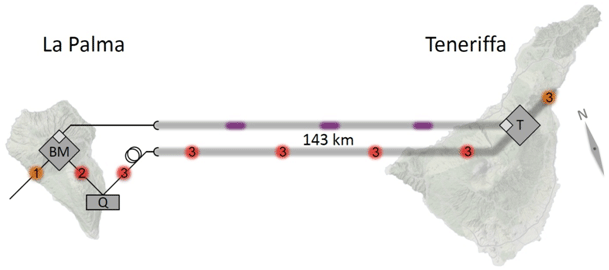World record: Quantum teleportation over 143 kilometres
Physicists from the group of Prof. Anton Zeilinger at the Institute of Quantum Optics and Quantum Information (IQOQI) and the University of Vienna have set a new world record for distance in quantum teleportation.
The team succeeded in teleporting the quantum state of a particle of light over a separation of 143 kilometres from the Canary Island La Palma to Tenerife. The experiment got theoretical support from Dr. Johannes Kofler from the group of Prof. Ignacio Cirac at the Max Planck Institute of Quantum Optics (MPQ). The results are published this week in Nature.
The so-called "quantum internet" is a future vision for information processing. It is not based anymore on classical computer networks but on the current developments of modern quantum information, where individual quantum particles are the carriers of information. Quantum networks promise absolutely secure communication and enhanced computation power for decentralised tasks compared to any conceivable classical technology. Due to the transmission losses in conventional glass fibres a global quantum network will likely base on the free-space transfer of quantum states, e.g., between satellites and from satellites to ground. The now realized quantum teleportation over a distance of 143 kilometres, beating a just a few months old Chinese record of 97 kilometres, is a significant step towards this future technology.
On the island of La Palma the team of physicists produced entangled pairs of particles of light (photons 2 and 3, see figure). Quantum entanglement means that none of the photons taken by itself has a definite polarisation but that, if one measures the polarisation of one of the photons and obtains a random result, the other photon will always show a perfectly correlated polarisation. This type of quantum correlation cannot be described by classical physics and Albert Einstein therefore called it “spooky action at a distance”. Photon 3 was then sent through the air to Tenerife, across the Atlantic Ocean at an altitude of about 2400 metres and over a distance of 143 kilometres, where it was caught by a telescope of the European Space Agency. Photon 2 remained in the laboratory at La Palma. There, the experimenters created additional particles of light (photon 1 in the figure) in a freely selectable polarization state which they wanted to teleport. This was achieved in several steps: First, a special kind of joint measurement, the so-called Bell measurement (“BM”), was performed on photons 1 and 2, which irrevocably destroys both photons. Two possible outcomes of this measurement were discriminated, and the corresponding classical information was sent via a conventional laser pulse (violet in the figure) to Tenerife. There, depending on which of the outcomes of the Bell measurement had been received, the polarization of photon 3 was either rotated by 90 degrees or left completely unchanged. This transformation (“T”) completed the teleportation process, and the polarization of photon 3 on Tenerife was now identical with the initial polarization of photon 1 on La Palma.
The complexity of the setup and the environmental conditions (changes of temperature, sand storms, fog, rain, snow) constituted a significant challenge for the experiment. They also demanded a combination of modern quantum optical technologies concerning the source of entangled particles of light, the measurement devices, and the temporal synchronization of the two laboratories. The experiment therefore represents a milestone, which demonstrates the maturity and applicability of these technologies for future global quantum networks. For the next step of satellite-based quantum teleportation an international collaboration of the Austrian and Chinese Academy of Sciences plans to shoot a satellite into space in the foreseeable future.

Figure: Schematic illustration of the teleportation experiment. The polarisation state of particles of light was teleported over a distance of 143 kilometres from the Canary Island La Palma to Tenerife. Graphic: IQOQI Vienna & MPQ.
Picture-download:
https://dl.dropbox.com/u/5536900/Nature/startrails-1.jpg (Copyright: IQOQI Wien)
https://dl.dropbox.com/u/5536900/Nature/startrails-2.jpg (Copyright: IQOQI Wien)
Contact:
Dr. Johannes Kofler
Max Planck Institute of Quantum Optics
Hans-Kopfermann-Straße 1, 85748 Garching
Phone: +49 (0)89 / 32 905 -242
E-mail: johannes.kofler@mpq.mpg.de
Dr. Olivia Meyer-Streng
Press & Public Relations
Max Planck Institute of Quantum Optics
Phone: +49 (0)89 / 32 905 -213
E-mail: olivia.meyer-streng@mpq.mpg.de
